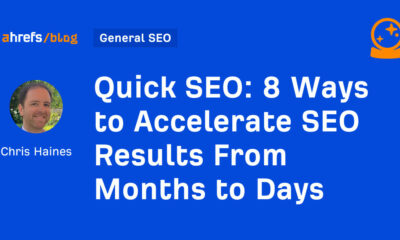SEO
11 Ways To Improve Rankings

How would you rate your small business SEO performance, and what should you focus on next for greater success?
SEO is the process of optimizing your site to rank higher in search engines such as Google, Bing, Yahoo, etc.
Your goal is to get in front of the searchers who could become your customers.
It’s important that your business appears in different types of search results, too – Google Maps, organic, Featured Snippets, images and videos, and more – in order to maximize your visibility.
Small business SEO is uniquely challenging in that you probably don’t have a dedicated SEO team or a lot of time to stay up to date on all the latest developments in search.
You’re competing not only against other small businesses but also publishers, big brands, and all kinds of other informational sources that appear in search results.
And, you definitely don’t have the budget those larger rivals do.
What’s a small business to do?
In this article, you’ll find an 11-point SEO checklist for small businesses that help you prioritize and focus on those SEO tasks that will really move the needle for you, including:
- What to address.
- Why it’s important.
- The tools to use.
- The time commitment involved.
1. Nail Down What Problems You Solve For Customers
Before jumping into SEO, you must first understand how people search. You can waste a lot of money in paid search targeting the wrong people, or delivering the right people the wrong message.
Knowing who you’re trying to reach and what problem you’ll solve for them is essential.
Start by asking yourself questions like:
- How, when, and where do customers determine they need your product or service?
- Is it away from home, using their cell phone? Is it at home using a desktop computer or tablet?
- Is it driven by a personal desire, like good food to eat or a great place to spend some time?
- Or is it caused by a disruptive event like a home or personal issue?
These questions color the language your customers will use to find your business.
This information will drive your keyword research and content creation, among other tasks.
(You can use these free keyword research tools to get you started.)
2. Fix Your Technical SEO Issues
Your small business website might look fine on the outside, with great graphics, colors, and fonts.
But if there are technical problems “under the hood,” it will likely impact your rankings and traffic.
Before embarking on a content or link campaign, spend time fixing the foundation.
You need a solid website structure so search engines can properly crawl and index your webpages.
Some of the most common technical SEO problems have to do with:
You’ll learn more about what it takes to conduct a technical SEO audit here.
3. Optimize Your Pages
On-page optimization is more than just putting a target keyword in strategic places on the page.
It’s important to develop properly structured, high-quality content written in natural language that incorporates your targeted keywords.
Use every reasonable (i.e., non-spammy) opportunity to add your targeted keywords appropriately on your website.
Otherwise, you’re missing important ranking signals. In other words, you must optimize your:
- Title tags and subheadings.
- Images and videos.
- Meta description.
- Body content.
- Internal links.
- And more – get the On-Page SEO Guide to learn more.
4. Optimize Your Google Business Profile
Your GBP strategy should be a focal point for any small business. It’s free, easy to update, and can make a big impact.
-
Screenshot from search for [san diego candy shop], Google, January 2022
Ideally, your Google Business Profile will provide all of the information a potential customer needs to call you, get driving directions, order online, or otherwise convert directly from the listing.
The first step toward optimizing your Google business listing is claiming and verifying it.
Be sure to fill out as many fields as you can and include photos and videos to enhance your listing.
Your category selection is super important. Be sure to choose the correct categories for your business.
The primary category guides which attributes and other features are available to you.
If you want to get more advanced with your Google Business Profile, take the time to create questions and answers.
What does that mean?
In local search results, there is a section on your listing where people can ask questions and get answers.
As a small business, it is important that you stay on top of these questions.
You can even create your own questions and provide the answers to proactively provide information that might help searchers convert.
Read The New Google Business Profile: A Complete Guide to learn more.
5. Find Out What Competitors Are Doing & Do It Better
Competitors online might be different than the competitors within your local area.
For SEO purposes, we are the most concerned with the websites that are showing up in the top five to 10 positions of Google search results for your targeted keywords.
Those are the competitors you want to analyze.
When doing a competitive analysis, use tools to find out:
- What those sites are ranking for.
- How many pages they have indexed.
- Their website structure.
- The quality of their backlink profile.
- Whether they’re ranking for long-tail keywords you could target.
Also, we know page speed is a factor in Google’s ranking algorithm.
Run their landing pages through page speed tools. Look for areas of weakness.
Google’s own Page Speed Insights is a great place to start.
-
 Screenshot from PageSpeed Insights, January 2022
Screenshot from PageSpeed Insights, January 2022
For example, are their pages running slow? Are there keywords they have missed that you can target?
See 3 Ways to Quickly Compare Your Website With Your Competitors for more helpful tips.
6. Manage Local Business Listings & Citations
In addition to Google My Business, you need to control the accuracy of your local business data.
Consistency is crucial.
Data aggregators (e.g., Neustar Localeze, Factual) share information about local businesses, including the name, address, and phone number (NAP).
Make sure your business’s NAP information is consistent and accurate. Local business listings and citations (i.e., online mentions of a business) can help improve your local presence.
It can be helpful to sign up for a service or use a local citations tool that will distribute your NAP information and monitor for inaccuracies.
7. Get Links From Websites In Your Local Area
Most small business owners never think about links.
However, getting links to your site can help improve your rankings.
That can mean more sales and more customers.
My approach to “link attraction” has always been more of a publicity angle.
What can we do to spread the word about our business, educate others, and get involved in the community?
You’ll find lots of tips and suggestions for local link building here.
8. Add Schema Markup
Schema markup helps search engines signals better understand different page components, such as:
- Business name.
- Address.
- Phone number.
- Ratings.
- Business hours.
- Currencies accepted.
- Area served.
- Number of employees.
- And a lot more.
Using this markup can help you appear in rich snippets in the SERPs.
-
 Screenshot from https://schema.org/LocalBusiness, January 2022
Screenshot from https://schema.org/LocalBusiness, January 2022
Check out all of the different types of schema available for local businesses here.
9. Focus On Getting Reviews
Even my kids are conditioned to look up reviews before making a purchase.
Local reviews were one of the leading local search ranking factors in 2021, according to Whitespark’s Local Search Ranking Factors report.
Plus, you can improve your conversions by putting effort into getting reviews and feedback from your customers.
Platforms can help you organize and manage a review campaign.
Or, you can simply encourage customers to leave reviews on the major online review sites.
These techniques can help you get more local reviews.
Make sure you respond, too. Your answer (or lack thereof) is not only visible to the person who asked the question but to all other local searchers who see the review in the future, as well.
Even negative reviews are an opportunity to connect with the customer and show others you care.
10. Create Videos & Images For Competitive Keywords
Websites need content, which means words, so that search engines understand what they are about.
Content goes beyond words, though, and should include images and videos.
In fact, if you are struggling to show up for competitive keywords, why not try a properly optimized video or an image?
As SEJ’s Anna Crowe wrote recently in her image optimization guide:
“Image optimization creates many advantages such as better user experience, faster page load times, and additional ranking opportunities.
And, it’s becoming an increasingly more important role.”
11. Mix Paid With Organic To Get Going
If you’re just starting out with SEO, it can take a while to see results.
SEO is a great long-term play, but sometimes you need to start generating leads right away. That is where paid search can really help.
While you are building up your SEO work, set aside a budget for paid, so that you can keep the leads coming in.
Even after you have a steady flow of organic traffic to the website, you might still consider running a paid search campaign in conjunction.
PPC ads can help augment your organic presence by giving you placement where you just haven’t been able to break into the top organic search results due to the competition.
Read more and find 10 tips for local paid search success here.
Summary
Even if the list of things to do seems overwhelming, the important thing is to just get started.
Begin with the first goal you know you can accomplish.
In time, you’ll discover local SEO tools that can make quicker, easier work of the tactics that are making a difference for you.
You’ll build more inbound links from relevant, reputable local sources.
You’ll add new blog posts and other content to your website, helping you rank on a greater variety of search terms.
And, once you’ve worked through the introductory items on this checklist, you’ll be ready to take your SEO strategy further.
I highly recommend Maddy Osman’s Complete Local SEO Checklist when you’re ready for that next level.
More resources:
Featured Image: Deemka Studio/Shutterstock
SEO
Executive Director Of WordPress Resigns

Josepha Haden Chomphosy, Executive Director of the WordPress Project, officially announced her resignation, ending a nine-year tenure. This comes just two weeks after Matt Mullenweg launched a controversial campaign against a managed WordPress host, which responded by filing a federal lawsuit against him and Automattic.
She posted an upbeat notice on her personal blog, reaffirming her belief in the open source community as positive economic force as well as the importance of strong opinions that are “loosely held.”
She wrote:
“This week marks my last as the Executive Director of the WordPress project. My time with WordPress has transformed me, both as a leader and an advocate. There’s still more to do in our shared quest to secure a self-sustaining future of the open source project that we all love, and my belief in our global community of contributors remains unchanged.
…I still believe that open source is an idea that can transform generations. I believe in the power of a good-hearted group of people. I believe in the importance of strong opinions, loosely held. And I believe the world will always need the more equitable opportunities that well-maintained open source can provide: access to knowledge and learning, easy-to-join peer and business networks, the amplification of unheard voices, and a chance to tap into economic opportunity for those who weren’t born into it.”
Turmoil At WordPress
The resignation comes amidst the backdrop of a conflict between WordPress co-founder Matt Mullenweg and the managed WordPress web host WP Engine, which has brought unprecedented turmoil within the WordPress community, including a federal lawsuit filed by WP Engine accusing Mullenweg of attempted extortion.
Resignation News Was Leaked
The news about the resignation was leaked on October 2nd by the founder of the WordPress news site WP Tavern (now owned by Matt Mullenweg), who tweeted that he had spoken with Josepha that evening, who announced her resignation.
He posted:
“I spoke with Josepha tonight. I can confirm that she’s no longer at Automattic.
She’s working on a statement for the community. She’s in good spirits despite the turmoil.”
Screenshot Of Deleted Tweet
Josepha tweeted the following response the next day:
“Ok, this is not how I expected that news to come to y’all. I apologize that this is the first many of you heard of it. Please don’t speculate about anything.”
Rocky Period For WordPress
While her resignation was somewhat of an open secret it’s still a significant event because of recent events at WordPress, including the resignations of 8.4% of Automattic employees as a result of an offer of a generous severance package to all employees who no longer wished to work there.
Read the official announcement:
Featured Image by Shutterstock/Wirestock Creators
SEO
8% Of Automattic Employees Choose To Resign

WordPress co-founder and Automattic CEO announced today that he offered Automattic employees the chance to resign with a severance pay and a total of 8.4 percent. Mullenweg offered $30,000 or six months of salary, whichever one is higher, with a total of 159 people taking his offer.
Reactions Of Automattic Employees
Given the recent controversies created by Mullenweg, one might be tempted to view the walkout as a vote of no-confidence in Mullenweg. But that would be a mistake because some of the employees announcing their resignations either praised Mullenweg or simply announced their resignation while many others tweeted how happy they are to stay at Automattic.
One former employee tweeted that he was sad about recent developments but also praised Mullenweg and Automattic as an employer.
He shared:
“Today was my last day at Automattic. I spent the last 2 years building large scale ML and generative AI infra and products, and a lot of time on robotics at night and on weekends.
I’m going to spend the next month taking a break, getting married, and visiting family in Australia.
I have some really fun ideas of things to build that I’ve been storing up for a while. Now I get to build them. Get in touch if you’d like to build AI products together.”
Another former employee, Naoko Takano, is a 14 year employee, an organizer of WordCamp conferences in Asia, a full-time WordPress contributor and Open Source Project Manager at Automattic announced on X (formerly Twitter) that today was her last day at Automattic with no additional comment.
She tweeted:
“Today was my last day at Automattic.
I’m actively exploring new career opportunities. If you know of any positions that align with my skills and experience!”
Naoko’s role at at WordPress was working with the global WordPress community to improve contributor experiences through the Five for the Future and Mentorship programs. Five for the Future is an important WordPress program that encourages organizations to donate 5% of their resources back into WordPress. Five for the Future is one of the issues Mullenweg had against WP Engine, asserting that they didn’t donate enough back into the community.
Mullenweg himself was bittersweet to see those employees go, writing in a blog post:
“It was an emotional roller coaster of a week. The day you hire someone you aren’t expecting them to resign or be fired, you’re hoping for a long and mutually beneficial relationship. Every resignation stings a bit.
However now, I feel much lighter. I’m grateful and thankful for all the people who took the offer, and even more excited to work with those who turned down $126M to stay. As the kids say, LFG!”
Read the entire announcement on Mullenweg’s blog:
Featured Image by Shutterstock/sdx15
SEO
YouTube Extends Shorts To 3 Minutes, Adds New Features

YouTube expands Shorts to 3 minutes, adds templates, AI tools, and the option to show fewer Shorts on the homepage.
- YouTube Shorts will allow 3-minute videos.
- New features include templates, enhanced remixing, and AI-generated video backgrounds.
- YouTube is adding a Shorts trends page and comment previews.
-

 WORDPRESS3 days ago
WORDPRESS3 days agoWordPress biz Automattic details WP Engine deal demands • The Register
-
SEARCHENGINES5 days ago
Daily Search Forum Recap: September 30, 2024
-

 SEO7 days ago
SEO7 days agoYoast Co-Founder Suggests A WordPress Contributor Board
-

 SEARCHENGINES6 days ago
SEARCHENGINES6 days agoGoogle Volatility With Gains & Losses, Updated Web Spam Policies, Cache Gone & More Search News
-

 SEO7 days ago
SEO7 days ago6 Things You Can Do to Compete With Big Sites
-
SEARCHENGINES4 days ago
Daily Search Forum Recap: October 1, 2024
-

 SEO6 days ago
SEO6 days agoAn In-Depth Guide For Businesses
-

 AFFILIATE MARKETING5 days ago
AFFILIATE MARKETING5 days agoNvidia CEO Jensen Huang Praises Nuclear Energy to Power AI















You must be logged in to post a comment Login